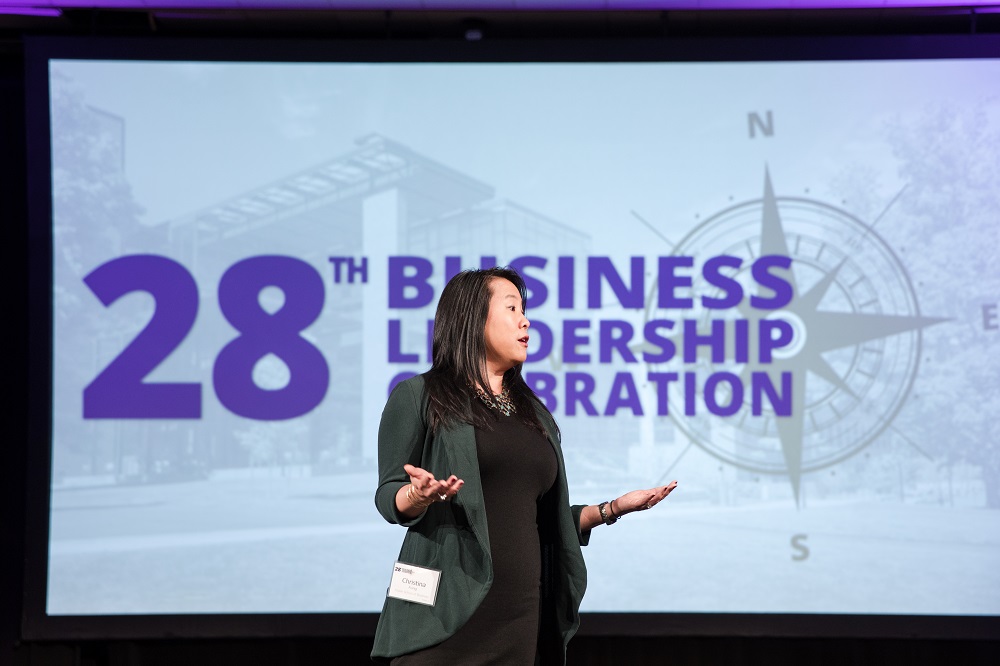BLC 2019: Christina Fong on the relative success of givers, takers and matchers
 The UW Foster School’s 28th annual Business Leadership Celebration featured a quintet of the school’s most-decorated faculty giving TED-style talks on different “Facets of Leadership.”
The UW Foster School’s 28th annual Business Leadership Celebration featured a quintet of the school’s most-decorated faculty giving TED-style talks on different “Facets of Leadership.”
Christina Fong, a principal lecturer of management and recipient of the 2015 Dean’s Leadership Award and the 2011 UW Distinguished Teaching Award, spoke on relational leadership, revealing the surprising differences in average performance between three types of personalities within an organization: givers, takers and matchers.
Here is the text of Christina’s lecture:
Everyone in this room realizes that how we approach our relationships is a key part of what drives our success as leaders.
In our leadership development class for Full-time and Evening MBA students, we talk about why and how we value our relationships.
And it turns out there are three different approaches to how we think about our social relationships.
Takers, givers and matchers
The first approach is embodied by a category of people that we’re going to call takers. Takers are people who look at their social relationships as a source of help and favors. So, a taker is really happy when, at the end of the year, they have received a lot of help and favors from many people and they haven’t had to help very many people.
Contrast that to another group of people: givers. Givers look at their social networks as a source for giving help and favors. So, at the end of the year, what the giver is looking for is the ability to say, I helped a lot of people and not very many people gave me help.
The third approach—and the most common group of people—are what we call matchers. Matchers are driven by equality and reciprocity. So, at the end of their year, they’re looking to see: are all the debts paid? They’re going to be happiest if everyone who I helped, helped me back; and if I repaid the favor to everyone who helped me.
Who does best?
The question is: who does best in life? And there’s lots and lots of really interesting research across all sorts of different domains that looks at how each approach drives leadership effectiveness.
Let’s start at the bottom of the ladder. Who are the worst performers? The students who get the worst grades, the salespeople with the worst sales record, the people least regarded by their peers?
The research tells us that the least successful people are actually the givers. Givers are the worst performers.
Now let’s talk about who’s at the top of the pyramid. Who are the best performers?
Once again, research shows that it is the givers.
In fact, what we see is that the givers live at the top and at the bottom of the hierarchy. And it’s the matchers and the takers who are at the mediocre middle.
The effective giver
Now, my very smart MBAs will ask: what is the difference between the successful givers and the unsuccessful givers?
And it turns out that unsuccessful givers often think about help as existing on a single continuum. I can either help you or I can help myself. But I can’t do both at the same time. And so if I’m choosing to help you, then I don’t think about myself. And what that leads to is what we would call a distracted doormat. Someone who is continually helping other people, but has no direction or vision.
In contrast, our successful givers are those who recognize that in fact these two things do not live on one single continuum. And they become most successful because they seek out those opportunities where helping themselves helps other people and vice-versa.
So successful givers have a vision and the courage to fight for that vision and set boundaries to make sure they’re working toward that vision, while also looking for opportunities to help others. Just because I’m going to be helpful to myself does not dissolve me of my responsibility of helping others as well.
Knowing about this research really empowers our students to be able to be the kind and generous and helpful people that they want to be, while also giving them the discipline to think about who they want to be and how they’re going to drive in that manner.

